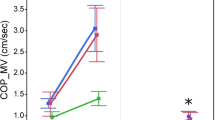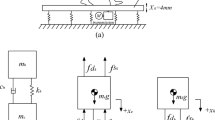Abstract
Purpose
Spinal cord injury (SCI) subjects use passive orthosis to assist them with the postural balance in daily life. Vertical vibrations are used to improve the postural balance of theses patients, mainly in terms of whole-body-vibrations, as in therapies. It is noteworthy to understand in what situation these patients are able to tolerate vertical vibrations while wearing orthosis. The main focus of this paper is to model vertical vibrations in the postural balance of arm free standing of the paraplegic subjects who use passive orthosis, and, mathematically understand the stability limits for these vibrations.
Methods
To find the stable amplitudes and frequencies, equations of motions of the system are translated into non-homogeneous Mathieu equations, which are then analytically solved and the results are numerically plotted. In addition, the effect of shoe stiffness on the amplitude and frequency of the vibrations which violate stability are studied.
Results
The results show to be sure of the stability of the paraplegics in vertical vibrations, the shoe sole of the orthosis should have high values of stiffness, and this will guarauntee bigger ranges of stable vibrations and safer stance for the patients.
Conclusion
Using the results, one can interpret how a paraplegic subject with passive orthosis may react to vertical perturbations, meaning, what ranges of frequencies and amplitudes of perturbations is tolerable without losing stability. This study is one of the necessities in designing new passive orthosis with more stability when exposed to perturbations.










Similar content being viewed by others
References
Giangregorio L, McCartney N (2006) Bone loss and muscle atrophy in spinal cord injury: epidemiology, fracture prediction, and rehabilitation strategies. J Spinal Cord Med 29(5):489–500
Castro MJ, Apple DF Jr, Hillegass EA, Dudley GA (1999) Influence of complete spinal cord injury on skeletal muscle cross-sectional area within the first 6 months of injury. Eur J Appl Physiol Occup Physiol 80(4):373–378
Shields RK (2002) Muscular, skeletal, and neural adaptations following spinal cord injury. J Orthop Sports Phys Ther 32(2):65–74
Tihanyi J, Di Giminiani R, Tihanyi T, Gyulai G, Trzaskoma L, Horváth M (2010) Low resonance frequency vibration affects strength of paretic and non-paretic leg differently in patients with stroke. Acta Physiol Hung 97(2):172–182
Bosco C, Colli R, Introini E, Cardinale M, Tsarpela O, Madella A, Tihanyi J, Viru A (1999) Adaptive respsonses of human skeletal muscle to vibration exposure. Clin Physiol 19(2):183
Ness LL, Field-Fote EC (2009) Whole-body vibration improves walking function in individuals with spinal cord injury: a pilot study. Gait Posture 30(4):436–440
Kvorning T, Bagger M, Caserotti P, Madsen K (2006) Effects of vibration and resistance training on neuromuscular and hormonal measures. Eur J Appl Physiol 96(5):615–625
Blottner D, Salanova M, Püttmann B, Schiffl G, Felsenberg D, Buehring B, Rittweger J (2006) Human skeletal muscle structure and function preserved by vibration muscle exercise following 55 days of bed rest. Eur J Appl Physiol 97(3):261–271
Alizadeh-Meghrazi M, Masani K, Popovic MR, Craven BC (2012) Whole-body vibration during passive standing in individuals with spinal cord injury: effects of plate choice, frequency, amplitude, and subject’s posture on vibration propagation. Pm&r 4(12):963–975
Cazani AC, Miyajima RH, Simões D, dos Santos JEG (2020) Operator exposure to whole-body vibration in timber extraction with grapple skidder. J Vib Eng Technol, pp. 1–6
Marzbanrad J, Shakhlavi SJ, Moghaddam IT-Z, Afkar A (2018) Biomechanical modeling of a seated human body exposed to vertical and horizontal vibrations using genetic algorithms. J Vib Eng Technol 6(5):417–426
Aboutorabi A, Arazpour M, Farahmand F, Bahramizadeh M, Fadayevatan R, Abdollahi E (2018) Design and evaluation of vibratory shoe on balance control for elderly subjects. Disabil Rehab Assist Technol 13(2):173–177
Priplata AA, Patritti BL, Niemi JB, Hughes R, Gravelle DC, Lipsitz LA, Veves A, Stein J, Bonato P, Collins JJ (2006) Noise-enhanced balance control in patients with diabetes and patients with stroke. Ann Neurol 59(1):4–12
Bahari H, Vette AH, Hebert JS, Rouhani H (2019) Predicted threshold against forward and backward loss of balance for perturbed walking. J Biomech 95:109315
Nayfeh AH, Mook DT (1979) Nonlinear Oscillations. John Wiley, New York
Younesian D, Esmailzadeh E, Sedaghati R (2005) Existence of periodic solutions for the generalized form of Mathieu equation. Nonlinear Dyn 39(4):335–348
Mond M, Cederbaum G, Khan PB, Zarmi Y (1993) Stability analysis of the non-linear Mathieu equation. J Sound Vib 167(1):77–89
Ng L, Rand R (2002) Bifurcations in a Mathieu equation with cubic nonlinearities. Chaos Solitons Fractals 14(2):173–181
Ng L, Rand R (2002) Bifurcations in a Mathieu equation with cubic nonlinearities: Part II. Commun Nonlinear Sci Numer Simul 7(3):107–121
Esmailzadeh E, Nakhaie-Jazar G (1997) Periodic solution of a Mathieu–Duffing type equation. Int J Non-Linear Mech 32(5):905–912
Abouhazim N, Belhaq M, Lakrad F (2005) Three-period quasi-periodic solutions in the self-excited quasi-periodic Mathieu oscillator. Nonlinear Dyn 39(4):395–409
Guennoun K, Houssni M, Belhaq M (2002) Quasi-periodic solutions and stability for a weakly damped nonlinear quasi-periodic Mathieu equation. Nonlinear Dyn 27(3):211–236
Lakrad F, Azouani A, Abouhazim N, Belhaq M (2005) Bursters and quasi-periodic solutions of a self-excited quasi-periodic Mathieu oscillator. Chaos Solitons Fractals 24(3):813–824
Rand R, Morrison T (2005) 2: 1: 1 resonance in the quasi-periodic Mathieu equation. Nonlinear Dyn 40(2):195–203
Zounes RS, Rand RH (2002) Global behavior of a nonlinear quasiperiodic Mathieu equation. Nonlinear Dyn 27(1):87–105
Younesian D, Esmailzadeh E, Sedaghati R (2007) Asymptotic solutions and stability analysis for generalized non-homogeneous Mathieu equation. Commun Nonlinear Sci Numer Simul 12(1):58–71
Keyvanara M, Sadigh MJ (2018) A new mathematical analysis of hip–knee–ankle–foot–orthosis for arm free standing of paraplegic subjects. In 2018 IEEE International Conference on Robotics and Biomimetics (ROBIO), pp. 2394–2398. IEEE, 2018
Coddington EA, Levinson N (1955) Theory of ordinary differential equations, Tata McGraw-Hill Education
Nayfeh AH (2008) Perturbation methods. Wiley, New York
Karimi MT (2010) Design and evaluation of the performance of a new type of reciprocal gait orthosis. PhD thesis, University of Strathclyde, Glasgow, Scotland
Author information
Authors and Affiliations
Corresponding author
Ethics declarations
Conflict of interest
On behalf of all authors, the corresponding author states that there is no conflict of interest.
Additional information
Publisher's Note
Springer Nature remains neutral with regard to jurisdictional claims in published maps and institutional affiliations.
Rights and permissions
About this article
Cite this article
Keyvanara, M., Sadigh, M.J. & Esfahanian, M. Stability Limits for Vertical Vibrations of Paraplegic Subjects while Using Passive Orthosis. J. Vib. Eng. Technol. 9, 399–407 (2021). https://doi.org/10.1007/s42417-020-00231-4
Received:
Revised:
Accepted:
Published:
Issue Date:
DOI: https://doi.org/10.1007/s42417-020-00231-4




